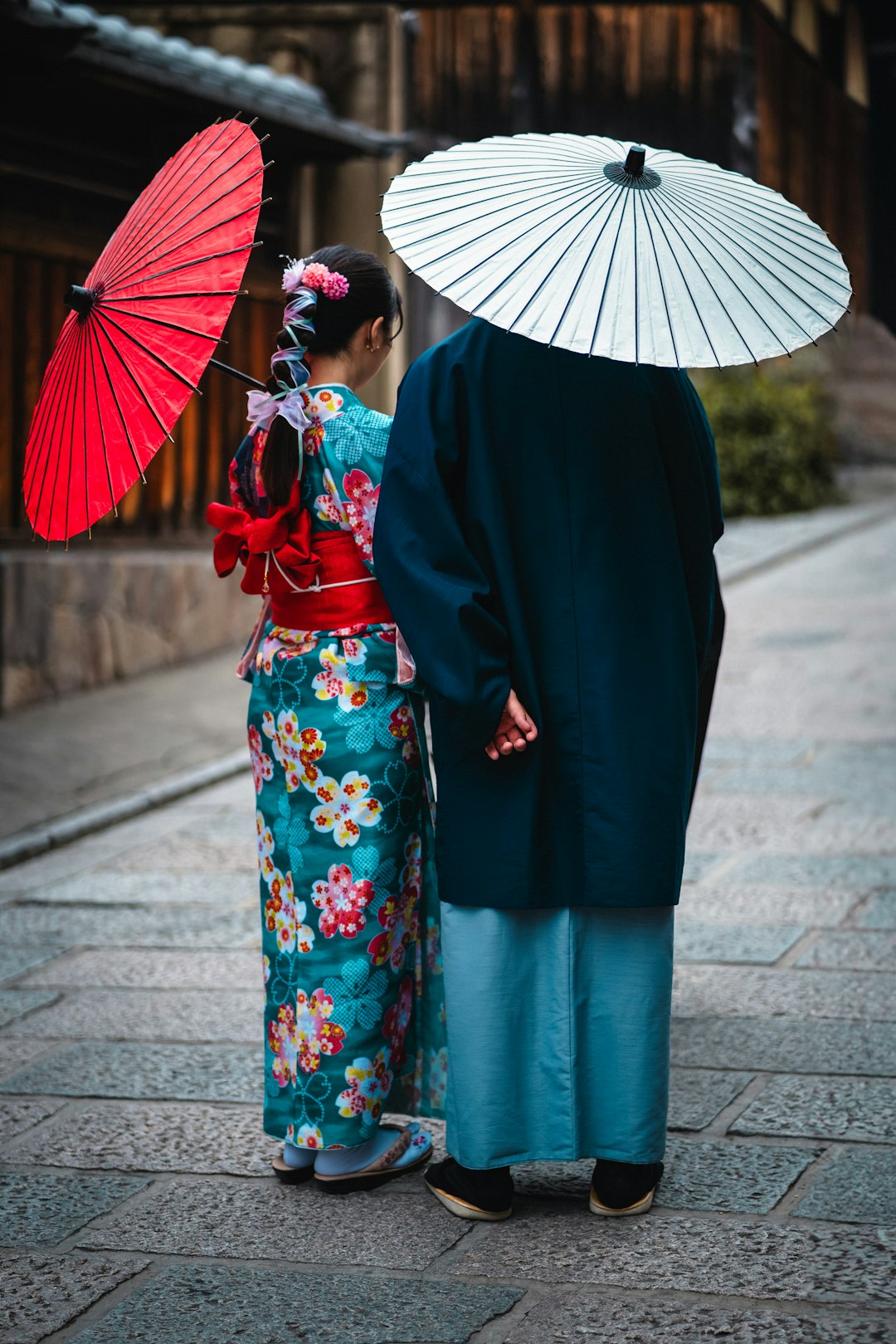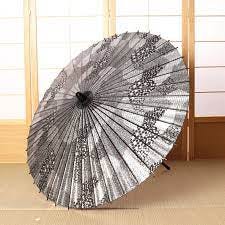Recently we have learnt about the many ways Japan shields itself from the sun, but I have neglected/ saved the most famous tool for a post of its own.
The parasol, or wagasa, is maybe Japan’s most enduring fashion icon. The famous wooden branched umbrella now generally only found in cocktail drinks, staged fashion shoots, or street art installations, dates back to at least the 10th century. Collectively known as wagasa, back in the early days they were essentially purely decorative, as being made of bamboo and paper they blocked neither rain nor sun. It would be wet tissue paper if water touched it, and quickly deteriorated in harsh sun. Less something that sheltered the user, and more something delicate that would need shelter itself.

Under my sunbrella
A couple centuries later they were improved upon with waxes and oils to be more waterproof, and a few after that they started being retractable. By the late 1500s, these had transformed into practical items that made being outside in the rain bearable. The colourful designs of the wagasa made them an icon that encapsulated Japan to the outside world.
The real secret of why wagasa has become such a key part of Japanese imagery is that the rest of the world didn’t actually figure out how to fold umbrellas until at least the 1920s, and other people registering a patent of the modern umbrella as late as 1969.
For foreigners visiting Japan in the 1600s, the folding wagasa must have seemed like magic. Back in those days, people were known to just carry umbrellas in all circumstances, with Jonas Hanway, “the British Father of Umbrellas”, famed for carrying his umbrella nonstop for 30 years. He was the first British man to use an umbrella, and was ridiculed for it. Knowing that these umbrellas never folded, I think some ridicule is justified given he must have arrived at every social event like Mary Poppins. British attitudes shifted over time and now the umbrella is as much a staple of English life as awful weather.
Modern Shade
With Japan historically leading the technological race for umbrellas, it is little wonder that the instrument is still central to modern life. In fact, the wagasa has transformed even further into their own subcategories, each rife with their own intricacies.
Firstly, I should clarify as I have been calling both umbrellas and parasols as wagasa. While this could technically be the same thing in past times, there is now a distinct difference. Wagasa still only refers to the bamboo made instrument not the machine-made umbrella that you might be more familiar with.
Within the wagasa world, the instruments are rightly treated as works of art, which has meant craftsmen often revert to traditional forms of handiwork. These days, the changes have evolved into modern parasols and umbrellas of which there are broadly three that see common use in Japan.
Parasols for only the sun
Parasols that are dual purpose with rain (晴雨兼用日傘 or 晴雨兼用傘)
Umbrellas that are dual purpose with the sun (晴雨兼用雨傘 or 雨晴兼用傘)
Version 1 is often a very decorative piece and is typically associated with feminine styles. By decorative, I mean made of linen or cotton and maybe not even a solid sheet. While these are distinctly useless in any form of weather than doesn’t involve clear skies, they compensate by fitting the retro style when taking photos in a kimono.
Version 2 and 3 sound remarkably similar but are for different seasons and weather patterns. With most parasol-first designs, these are now fitted with UV protective coating. It sacrifices the heavy downpour defense stat boost that all good umbrellas should have, having optimised for heat and UV protection. To that end, these are found in three colours, all purporting to defend against the sun: Black as the best UV defence, white to reduce heat, or silver to reflect the suns rays. Maybe each have unique properties, or maybe they are designed to sell another two parasols to unsuspecting customers.
Whatever the case, each should have an SPF label that highlights what level of actual protection you’re getting. Most regular sunbrellas have 99.99% sun protection but if you need a total shielding, Japan has you covered. Very high end brands such as Sun Barrier 100 and Ashiya Rose Blanc offer 100% defense for the vampires and sun allergic amongst us. At these price points, colour no longer matters and any design gives that full protection. For the serious outdoor enjoyers, these are perfect for summer or as a civilian defense against space lasers.
With version 3 umbrella-first designs, innovation has also not ceased. Modern umbrellapreneurs have optimised beyond rain protection. My personal favourite is the inverted umbrella, being both affordable and a useful product. This isn’t the inversion caused by heavy winds (although there are also supposedly windproof umbrellas) What this entails is the inversion when you close the umbrella. The part that touches the rain is kept inside and the hopefully dry part stays outside. This flipping minimises dripping. These are easily found in the 300 yen stores across Japan, although I’m less familiar with the high end umbrella scene.
A final distinctly 2020’s Japanese marketing of umbrellas has been to present them as inbuilt social distancing. During the summer frenzy of Covid, according to the Asahi Shinbun in hot cities like Kumagaya and Toyota, elementary students were told to not wear masks to avoid heat sickness and instead carry an open umbrella to and from school. This umbrella distancing was even present at art exhibitions and theme parks. While I’m dubious of the effect given narrow Japanese city sidewalks, this adaptation showcases how umbrella innovation shifts with the times.
In whatever case of protective instrument from Edo-style to cutting edge, there is an umbrella design for you. If there’s ever a place to buy portable shade or if you are just umbrella and parasol-curious, consider Japan.






This was such an interesting piece! I never realised that the umbrella was only invented in the west in the 1920s!
Great article. :)
Really interesting! I learnt a lot from reading this piece. Thanks for sharing the research that went into it. :)